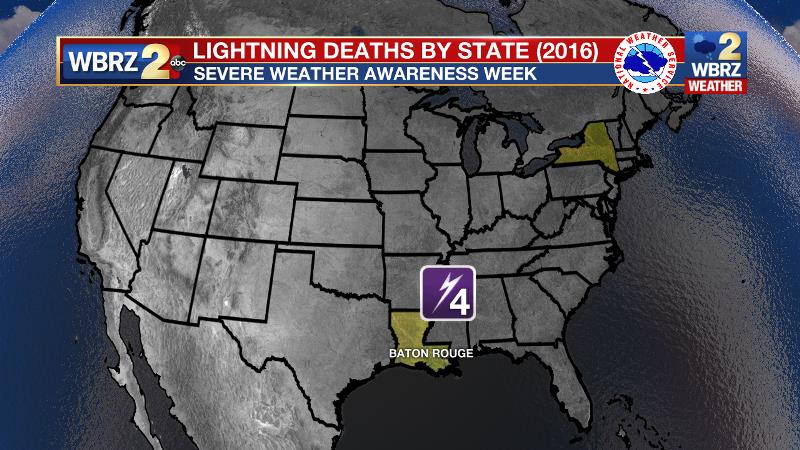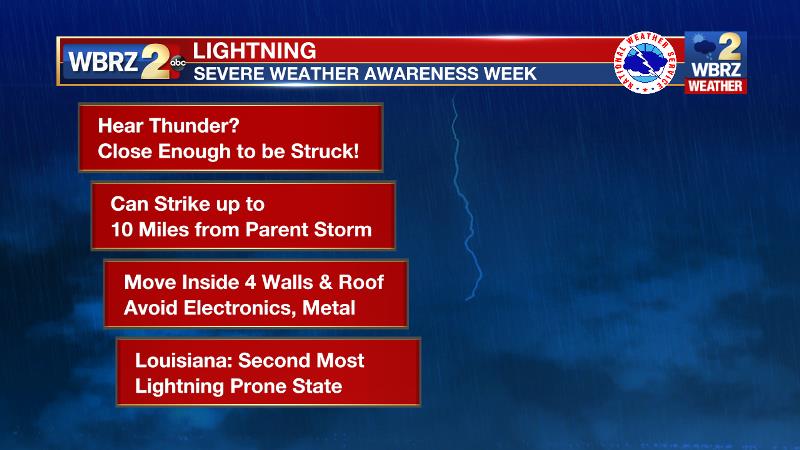What you should know: lightning
Lightning kills every year, averaging 49 deaths annually in the United States. Few areas see more lightning than Louisiana and because it happens so often, locals have a tendency to take it lightly. 4 people were killed by lightning in Louisiana last year—one in Baton Rouge. All four were outside. Lightning strikes the United States about 25 million times a year. Although most lightning occurs in the summer, people can be struck at any time of year.

The fact is, if you can hear thunder, lightning is close enough to strike. Too many people wait far too long to get to a safe place when thunderstorms approach. Unfortunately, these delayed actions lead to many of the lightning deaths and injuries in the United States. It can, and has struck up to 10 miles from the parent thunderstorm! So “when thunder roars go indoors!” Move into a well-constructed building and avoid electronics or metal surfaces.
The best way for you to protect yourself from lightning is to avoid the threat. You simply don’t want to be caught outside in a storm. Monitor weather conditions and get to a safe place before the weather becomes threatening. Substantial buildings and hard-topped vehicles are safe options. Covered patios, rain shelters, small sheds, and open vehicles are not safe. When inside, do not touch anything that is plugged into an electrical outlet. Cell phones and cordless phones are safe. Also, keep away from outside doors and windows and do not lie on a garage floor.

Stay ahead of severe weather; stay in touch with our weather team on Facebook and Twitter. For more on severe weather awareness week and severe weather safety, CLICK HERE.
Trending News
There is little you can do to substantially reduce your risk if you are outside in a thunderstorm. The only completely safe action is to get inside a safe building or vehicle.
Sports: The weather forecast calls for partly cloudy skies, with a chance of thunderstorms by early evening. When you arrive at the park, you notice the only safe buildings are the restrooms. Shortly after sunset, the sky gets cloudy and you see bright flashes in the sky. What should you do? Get everyone into vehicles or the restrooms. Do NOT stay in the dugouts; they are not safe during lightning activity. Once in a safe place, wait 30 minutes after the last rumble of thunder before resuming play.
Beach or Lake: The weather forecast calls for a nice morning followed by a 30 percent chance of afternoon thunderstorms. When you get to the beach, you see that the only nearby structures are open-sided picnic shelters. The parking lot is a 5 minute walk from the beach. By early afternoon skies are darkening and hear distant thunder. What should you do? Go to your car! Do NOT seek shelter under the beach picnic shelters. Wait 30 minutes until after the last rumble of thunder before going back to the beach.
Park or Wilderness: You're cooking dinner on the camp stove when you hear distant rumbles of thunder. Your tent and a large open sided picnic shelter are nearby. Your vehicle is about quarter of a mile away parked at the trail head. What should you do? Go to your vehicle! The tent and picnic shelter are NOT safe places. Wait 30 minutes until after the last rumble of thunder before going back to the campsite. For those who cannot get to a vehicle, here are tips from the National Outdoor Leadership School on what to do in the back country, in a canoe, etc., as a last resort.
If you absolutely cannot get to safety, you can slightly lessen the threat of being struck with the following tips. But don't kid yourself--you are NOT safe outside. Know the weather patterns of the area you plan to visit. For example, in mountainous areas, thunderstorms typically develop in the early afternoon, so plan to hike early in the day and be down the mountain by noon. Listen to the weather forecast for the outdoor area you plan to visit. The forecast may be very different from the one near your home. If there is a high chance of thunderstorms, stay inside.
- Avoid open fields, the top of a hill or a ridge top.
- Stay away from tall, isolated trees or other tall objects. If you are in a forest, stay near a lower stand of trees.
- If you are in a group, spread out to avoid the current traveling between group members.
- If you are camping in an open area, set up camp in a valley, ravine or other low area. Remember, a tent offers NO protection from lighting.
- Stay away from water, wet items, such as ropes, and metal objects, such as fences and poles. Water and metal do not attract lightning but they are excellent conductors of electricity. The current from a lightning flash will easily travel for long distances.
Protect yourself when on a bicycle, motorcycle or dirt bike. Carry a portable NOAA Weather Radio or listen to commercial radio. If you see threatening skies in the distance and you are near a safe building, pull over and wait 30 minutes after the last rumble of thunder before resuming your ride. The vast majority of lightning injuries and deaths on boats occur on small boats with NO cabin. It is crucial to listen to weather information when you are boating. If thunderstorms are forecast, do not go out. If you are out and cannot get back to land and safety, drop anchor and get as low as possible. Large boats with cabins, especially those with lightning protection systems properly installed, or metal marine vessels are relatively safe. Remember to stay inside the cabin and away from any metal surfaces. Stay off the radio unless it is an emergency!
Below are some key safety tips for you, your pets and your home. There are three main ways lightning enters structures: a direct strike, through wires or pipes that extend outside the structure, and through the ground. Once in a structure, lightning can travel through the electrical, phone, plumbing, and radio/television reception systems. Lightning can also travel through any metal wires or bars in concrete walls or flooring.
- Stay off corded phones. You can use cellular or cordless phones.
- Don't touch electrical equipment such as computers, TVs, or cords. You can remote controls safety.
- Avoid plumbing. Do not wash your hands, take a shower or wash dishes.
- Stay away from windows and doors that might have small leaks around the sides to let in lightning, and stay off porches.
- Do not lie on concrete floors or lean againt concrete walls.
- Protect your pets: Dog houses are not safe shelters. Dogs that are chained to trees or on metal runners are particularly vulnerable to lightning strikes.
- Protect your property: Lightning generates electric surges that can damage electronic equipment some distance from the actual strike. Typical surge protectors will not protect equipment from a lightning strike. The American Meteorological Society has tips for protecting your electronics from lightning. Do not unplug equipment during a thunderstorm as there is a risk you could be struck.


